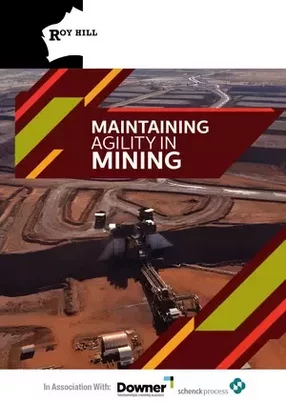“Roy Hill is a US$10bn mega iron ore mining and infrastructure operation and Australia’s single largest iron ore mine capable of producing 55mn tonnes of ore per year. Headquartered in Western Australia, we are the only independent iron ore operation with significant local ownership,” advises Barry Fitzgerald, Chief Executive Officer of Roy Hill Holdings.
The industry has suffered a difficult time of late, and one set to continue according to HSBC, which predicts that prices will likely correct further in the current quarter, seeing the benchmark price for 62% fines fall below US$60 a tonne over the first half of next year. As the single biggest player within Australia’s iron sector, Roy Hill has understandably taken measures to protect against the negative effects of any market volatility.
“When we set up our business four years ago, market conditions were very different. At Roy Hill, we regularly review our business strategy and work within the parameters of the changed market environment. We act, refocus and maintain our agility so we can adapt and respond to market changes,” Fitzgerald comments.
“Our unique and best-in-class integrated demand to supply chain operating, reporting and monitoring systems ensures a holistic view across the entire organisation from mine to port. We maintain constant contact with our customers on matters of product quality.
“As a margin driven business, we focus on innovation and business improvement methodology to foster efficiency, effectiveness and engagement regardless of price. This discipline and drive to recruit people who understand our values of Lead, Care, Think, and Perform positions us well to weather an uncertain market.”
Embracing change
Western Australia accounts for about 98% of Australia's Economic Demonstrated Resources (EDR) of iron ore, which is around 28bn tonnes. As such, the state government plays an important role in the operations at Roy Hill. “In addition to continuing to drive our costs lower, it is imperative that both the state and commonwealth governments continue to work with the industry to reduce compliance costs and the regulatory burden that is imposed on the sector,” Fitzgerald continues. “Collaboration with other companies and engaging with government to ensure that policy shifts occur to support future growth, expansion and investment is key.”
The compliance costs and regulatory burden – Western Australia has enacted health and safety regimes that apply specifically to mining workplaces, which impose strict rules aimed at establishing a high level of safety and carry significant penalties for non-compliance – often impact the viability of mining projects.
“The willingness to embrace change, consider innovation in design and identify modern technologies must be improved. This approach to improvement and innovation should be integrated into organisational culture. The ability for organisations to transform is also limited by the capacity of its leadership to thrive in a world that is increasingly volatile and complex. It is imperative that organisations prioritise vertical leadership development over horizontal skills development,” observes Fitzgerald.
The digital economy
Australia has the world’s largest estimated reserves of iron ore with 54bn tonnes, 28% of the world’s estimated 190bn tonnes. As such, the country’s majors can benefit from effectively supporting METS (mining equipment, technology and services). “Increasingly, METS are seeking to adapt and position themselves as relevant in the digital economy. This is creating opportunities for them to play a more substantive role within the value, or supply chains, of majors,” states Fitzgerald.
“Investments by METS into research and development and data analytics has the potential to unlock value in the supply chain.” Indeed, supply chain development is seen by many to be key to the future of the mining industry. “Our integrated operating model has redefined how Roy Hill works day to day. Our unique approach breaks down traditional barriers by realigning everything we do according to five interdependent and interconnected systems (supply, demand, people, improvement governance), allowing us to take a holistic view of our operations,” Fitzgerald elaborates.
“Supply places our maintenance teams as core business and optimises the flow of parts, contractors and equipment to maximise availability and reliability. We recognise that the digital economy is offering greater opportunity to change the world of work and this has led to improvements in supply chain capability.”
See also:
- Mineral Technologies: The art and science of separation
- Serving Senegal: Inside Bassari Resources’ Makabingui gold project
- An introduction from the Kenya Ministry of Mines
Driving innovation
Not content to follow the crowd, Roy Hill has pioneered the use of new practices within its operations. “In a shift from standard industry practice, we have decided to ‘in-source’ our supply system – centralising our maintenance planning and engineering services then housing all supply system functions together to increase collaboration. This is a critical step in improving the throughput relationships between our suppliers and our customers,” reveals Fitzgerald.
“At Roy Hill, we have been future-proofing from the start with significant investments in technology and attracting and developing our people. With technology as a foundation of our business, we have been driving key innovations by collaborating with suppliers to stretch software and services beyond the limit of current thinking, thus providing best-practice across the business.”
Sustainable production
Roy Hill has a defined mineralisation of more than 2.2bt of +50% Fe iron ore of which 1.2bt is +55% Fe, enough to sustain a mine life of more than 17 years. With this in mind, Roy Hill is already looking to the future. “We are focused on reaching sustainable 55Mtpa production, and continuing to get the best results from our people and our assets every single day,” enthuses Fitzgerald. “Over the next 12 months, we will bring on another 300 employees, taking our total to around 2,000 employees.”
- Onslow Iron's first transhipper launchedSupply Chain & Operations
- Samarco, a Vale-BHP JV, plans to raise $2bn in restructuringSupply Chain & Operations
- Unmanned train to allow Vale to reopen iron ore plantSupply Chain & Operations
- Mining Profile: Eduardo Bartolomeo, CEO, ValeSupply Chain & Operations


